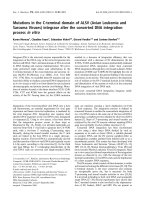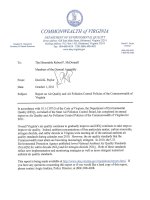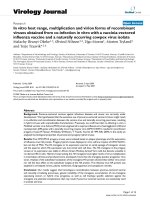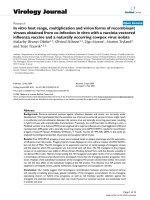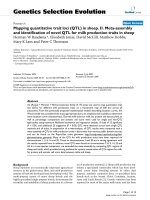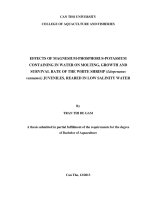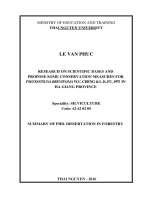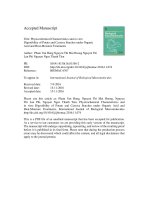Completing the production process in vitro on hana strawberries and investigating the control factor for strawberry flowering
Bạn đang xem bản rút gọn của tài liệu. Xem và tải ngay bản đầy đủ của tài liệu tại đây (2.26 MB, 63 trang )
VIETNAM NATIONAL UNIVERSITY OF AGRICULTURE
FACULTY OF BIOTECHNOLOGY
GRADUATE THESIS
COMPLETING THE PRODUCTION PROCESS IN VITRO ON
HANA STRAWBERRIES AND INVESTIGATING THE
CONTROL FACTOR FOR STRAWBERRY FLOWERING
Hanoi - 2021
VIETNAM NATIONAL UNIVERSITY OF AGRICULTURE
FACULTY OF BIOTECHNOLOGY
GRADUATE THESIS
COMPLETING THE PRODUCTION PROCESS IN VITRO ON
HANA STRAWBERRIES AND INVESTIGATING THE
CONTROL FACTOR FOR STRAWBERRY FLOWERING
Practicing student
Mao Thi Thuy Trang
Class
K61CNSHE
Student code
610684
Supervisor
Nguyen Thanh Hai, Ph.D
Hanoi - 2021
COMMITMENT
I hereby declare that all information in this document has been obtained
and presented in accordance with academic rules and ethical conduct.
I also declare that all the help to complete this thesis has been thanks.
i
ACKNOWLEDGEMENT
This study would not have been possible without the support of many
people. I would like to express my gratitude to my professors of Department of
Plant Biotechnology at Faculty of Biotechnology in Vietnam National
University of Agriculture for their support and conducting the research.
Particular thanks to Nguyen Thanh Hai, Ph.D for his valuable comments
and helpful advice, scientific guidance and valuable feedback throughout
the time at laboratory of Department of Plant Biotechnology, especially with me
work.
Finally, I wish to express my special thanks to my family for their great
encouragement throughout my project and thesis, as well as my friends for their
continual supports.
ii
Table of Contents
COMMITMENT .................................................................................................... i
ACKNOWLEDGEMENT .................................................................................... ii
ABBREVIATIONS ............................................................................................... v
LIST OF TABLES ............................................................................................... vi
LIST OF FIGURE ............................................................................................... vii
I. INTRODUCTION ............................................................................................. 1
1.1. Problem .......................................................................................................... 1
1.2. Purpose and requirement ................................................................................ 2
1.2.1. Purpose........................................................................................................ 2
1.2.2. Requirement ................................................................................................ 2
1.3. Research location ........................................................................................... 2
II. LITERATURE REVIEW ................................................................................. 3
2.1. General introduction ....................................................................................... 3
2.2. Origin.............................................................................................................. 3
2.3. Distribution..................................................................................................... 4
2.4. Category ......................................................................................................... 4
2.5. Botanical characteristics ................................................................................. 5
2.6. Strawberry diseases ........................................................................................ 6
2.6.1. Causes of the disease: ................................................................................. 6
2.6.2. The most common strawberry diseases ....................................................... 7
2.7. Nutritional value and economic value ......................................................... 18
2.8. Factors regulating development ................................................................... 20
2.9. Research in the world and in Vietnam ......................................................... 22
III. Materials and experiments ............................................................................ 25
3.1. Material. ....................................................................................................... 25
3.2. Experiments. ................................................................................................. 25
3.2.1. Production process of in vitro strawberry. ............................................... 25
iii
3.2.2. Survey of plant physiological properties controlling strawberry flowering
............................................................................................................................. 27
3.2.3. Rooting ...................................................................................................... 27
IV. EXPERIMENT COMPLETED .................................................................... 28
V. CONCLUSIONS AND SUGGESTIONS ...................................................... 42
VI. REFERENCES.............................................................................................. 43
iv
ABBREVIATIONS
Abbreviation
Full form
AC
Activated charcoal
BA
N6 Benzylaminopurine
IBA
Indole-3-butyric acid
NAA
1-naphthaleneacetic acid
MS
Murashige and Skoog medium
TDZ
Thidiazumron
2,4-D
2,4-dichlorophenoxy-acetic acid
GA3
Gibberellic acid
CV
Cultivar
GA3
Gibberelic acid
CT
Formular
v
LIST OF TABLES
Table 4.1. Influence of disinfectant to the stage to create the initial materials .. 30
Table 4.2. Effect of BA on the multiplication of strawberry after 5 weeks ........ 31
Table 4.3. Effect of BA and Glutamine on the multiplication of strawberry after
5 weeks ................................................................................................................ 33
Table 4.4. Effect of BA and coconut water on the multiplication of strawberry
after 5 weeks........................................................................................................ 35
Table 4.5. Effect of Reduced lighting hours on the flowering of strawberry after
4 weeks ................................................................................................................ 37
Table 4.6. Effects of AC on rooting ability of strawberry shoots after 3 weeks 38
Table 4.7. Effects of α-NAA on rooting ability of strawberry shoots after 3
weeks ................................................................................................................... 39
Table 4.8.Effects of IBA on rooting ability of strawberry shoots after 3 weeks 41
vi
LIST OF FIGURE
Figure 2.1 Hemorrhoids on strawberries............................................................... 7
Figure 2.2 Helix aspersa Slug on strawberries ...................................................... 9
Figure 2.3 White powder disease on leaf ............................................................ 10
Figure 2.4 White chalk disease on strawberry plants.......................................... 10
Figure 2.5 Rubber disease ................................................................................... 11
Figure 2.6 Black spot disease .............................................................................. 12
Figure 2.7 Gray mold on strawberry plants ........................................................ 13
Figure 2.8 Gray mold on strawberry diseases ..................................................... 14
Figure 2.9 Blackberry root rot ............................................................................. 15
Figure 2.10 Red Spider........................................................................................ 16
Figure 2.11 Tetranycus Urticae red spider .......................................................... 18
Figure 4.1. The shoots of strawberry create the initial materials ........................ 28
Figure 4.2. Strawberry shoots in vitro after sterilization on background medium
after 4 weeks........................................................................................................ 30
Figure 4.3. Strawberry shoots in vitro on basic medium supplemented with BA
after 5 weeks........................................................................................................ 32
Figure 4.4. Strawberry shoots in vitro on basic medium supplemented with BA
and Glutamine after 5 weeks ............................................................................... 34
Figure 4.5. Strawberry shoots in vitro on basic medium supplemented with BA
and Coconut water after 5 weeks ........................................................................ 36
Figure 4.6. The shoots young of strawberry in lighting hours is 10h ................. 37
Figure 4.7. Roots of strawberry shoots on basic medium supplemented with AC
after 3 weeks........................................................................................................ 39
Figure 4.8. Roots of strawberry shoots on basic medium supplemented with αNAA after 3 weeks .............................................................................................. 40
Figure 4.9. Roots of strawberry shoots on basic medium supplemented with IBA
after 3 weeks........................................................................................................ 41
vii
I. INTRODUCTION
1.1. Problem
The strawberry is a perennial which arises from a crown of meristematic
tissue or compressed stem tissue. Leaves, stems, runners, axillary crowns,
inflorescences, and roots all arise from the crown. The plant has trifoliate leaves
which spiral around the crown, with buds in the leaf axils giving rise to the
runners. Runners have two nodes with a plant produced at the distal node.
Strawberry blossoms contain many pistils, each with its own style and stigma
attached to the receptacle. When fertilization occurs the receptacle develops into
a fleshy fruit (Darnell, R., 2003).
The fruit is called an achene which contains the seeds. The edible part is an
accessory type fruit. The seeds are arranged on the outside of the receptacle
tissue. The growth of the receptacle is dependent on successful fertilization of
the ovules with its size and shape dependent on the number of achenes formed.
Strawberry plants are day length dependent with cultivars being long day, short
day or day neutral (Darnell, R., 2003).
Following further hybridizations, especially since 1850, strawberries has
developed into the large, fragrant, tasty red fruit that is now cultivated
worldwide. The high degree of genetic heterozygosity present in Fragaria spp.
enabled the development of strawberry cultivars adapted to widely varying
environment conditions and resistant to several diseases and pests. Not only the
genetic variability, but also a high adaptability and plasticity of the strawberry
plant itself give this crop such a remarkable range of adaptation (Darrow, G.M.,
1966).
That heterozygosity was explained by (Gaafar and Saker 2006) as there are
more than 20 Fragaria species worldwide, there are seven basic types of
chromosomes that they all have in common. However, they exhibit different
polyploidy. Some species are diploid, having two sets of the seven
chromosomes (14 chromosomes total). Others are tetraploid (4x = 28),
1
hexaploid (6x = 42), octoploid (8x = 56) or decaploid (10x = 70) (Emarah.,
2008).
1.2. Purpose and requirement
1.2.1. Purpose
- Find the best process to propagate in vitro for stable quality, high
multiplier.
- Apply in vitro propagation process in production for good seedling
quality, take initiative in production.
1.2.2. Requirement
- Redefine the appropriate fast multiplication environment.
- Redefine the medium to create suitable complete roots.
- Find the suitable lighting time to increase yield and prolong the harvest of
strawberry.
1.3. Research location
- The study was performed at Department of Plant Biotechnology, Faculty
of Biotechnology and Institute of Agro- Biology in Vietnam Nation University
of Agriculture.
2
II. LITERATURE REVIEW
2.1. General introduction
The strawberry - Fragaria is scientifically known, is a highly economical
crop. It’s a fruit with very high nutritional value, contain a lot of vitamin C,
malic acid, rich in fiber, antioxidants. This fruit has many benefits for human
health and provides a relatively high source of income for strawberry growers.
2.2. Origin
Strawberries ( scientific name : Fragaria ), also known as strawberry is a
genus
of flowering
plants and
species of
flowering
plants belonging
to Rosaceae ( Rosaceae ) for fruits are more popular. Strawberries originated in
the Americas and were bred by European gardeners in the 18th century to create
a widely cultivated strawberry variety today. This species was first scientifically
described by (Weston) Duchesne in 1788.
In 2012, a Japanese guy named Nahana Shojiro decided to live in Vietnam
and chose Moc Chau as a stopover land. He brought along the famous
Tochiotome strawberry from the famous Tochigi region. After bringing
Tochiotme strawberry varieties planted experimentally in Moc Chau, after a
period of living and working hard with passion and rightly, he chose Moc Chau
to stop. Japanese strawberry variety has established a certain brand in this
plateau.
Tochiotome strawberry variety has gradually been adopted by consumers
by planting on Moc Chau land on sunny days, cold nights, making Japanese
strawberries much sweeter than strawberries Da Lat or Korea. The deep
sweetness of the Tochiotome Japanese strawberry variety is very suitable for the
taste of Vietnamese consumers. Because this strawberry variety has a long
Japanese name that makes it difficult for Moc Chau and Son La people to call,
then they took the name of Japanese farmer Nahana Shojiro to name this
strawberry variety, short for easy Remember "Hana Strawberry”.
3
2.3. Distribution
Strawberries adapt to a variety of ecology: temperate, Mediterranean,
subtropical and sub-temperate. Around the world, strawberries are grown in
many countries such as the US, France, Japan, the Netherlands ...
Currently, Tochiotome (Hana) of Japan has been propagated and grown
popularly in Moc Chau, Son La as well as many provinces from North to South.
2.4. Category
There are over 20 different varieties of strawberries around the world. The
key to classifying strawberries is based on their number of chromosomes . There
are 7 basic types of chromosomes that all have in common. However, they
exhibit different polyploidy. Some species are diploid, having 2 sets containing
7 chromosomes (2n = 14). Other species are tetraploids (4 sets, 4n = 28),
hexadecimal (6 sets, 6n = 42), octal (8 sets, 8n = 56) or multiple (10 sets, 10n =
70).
As a rule of thumb (with some exceptions), strawberries with more
chromosomes tend to produce larger, healthier plants with larger berries
(according to Darrow).
Diploid
Fragaria daltoniana
Fragaria iinumae
Fragaria nilgerrensis
Fragaria nipponica
Fragaria nubicola
Fragaria vesca
Fragaria viridis
Fragaria yezoensis
Quadruple
STRAWBERRY moupinensis
4
Fragaria orientalis
Hexaploid
Fragaria moschata (muskberry)
Bat multiples and hybrid
Fragaria x ananassa (Garden strawberry)
Fragaria chiloensis (Chilean strawberry)
Fragaria iturupensis (Iturup Strawberry)
Fragaria virginiana (Virginia Strawberry)
Cross and hybrid
Fragaria × Potentilla
Fragaria × vescana
2.5. Botanical characteristics
Body: Belongs to herbaceous plants, perennial, short-stemmed with many
leaves growing very close together. Axillary buds are grown from axillary buds,
depending on environmental conditions and flowering characteristics of each
variety, axillary buds can develop into stems, bovine stems or flower.
Leaves: Leaves have the shape, structure, thickness and amount of
undercoat, depending on the variety. Most strawberry varieties have double
leaves with 3 leaflets, some varieties have doublet leaves with 4 or 5
leaflets. The edges are serrated. The petiole is long, the petiole is usually white
when the leaves are young, and turns red when the leaves are old.
Flower: Divided into many branches, each branch has a flower. The flower
has 5 thin, white, slightly rounded petals. Flowers are hermaphrodite, have 2530 stamens and 50-500 stamens. Strawberries are fertile but through selfpollination to increase the frequency of desired genes and to produce some
species.
Fruit: is a kind of fake fruit due to the bulging flower base, it is indeed
located on the outside of the fake fruit. The fruit is oval in shape; the young fruit
is green. When the fruit is ripe, the fruit is pink or red depending on the
5
variety. Strawberries are fragrant, sweet and sour. (Lucy, 2017)
Roots: A root system, roots develop about 30 cm from the ground.
2.6. Strawberry diseases
2.6.1. Causes of the disease:
Weather: If it is cold, the stamens will die leading to brown flowers, if the
weather is too cold, the flower will die, some of the flowers that have been
pollinated will survive and make the flower deform. In the cold season, when
the temperature is too low, the cells are frozen, the base is browned, the plant is
poorly grown, and is susceptible to pests and diseases.
Light intensity: The light intensity is high, the cells will die, there are
circular marks on the leaves.
Hail: Hail causes leaves, flowers and fruit to be crushed, creating
opportunities for pathogens to penetrate, greatly damaged plants, causing brown
marks on leaves due to scratches.
- Nutritional disorders:
+ Nitrogen: Initially, the plant needs a great amount of nitrogen. If there is
a lack of protein leaves, the fruit will be small, the tree will give a little look, the
old leaves turn orange or red, the young young and pale green. Excess nitrogen
reduces
fruit
quality,
and
plants
are
susceptible
to
disease.
Analyzing soil samples and based on growth and symptoms of plants to adjust
nitrogen accordingly.
+ Potassium: Potassium- deficient plants are wilted, old leaves are dry, and
fruits are easy to rot.
Using potassium bicarbonate sprayed on can prevent disease and provide
more potassium to the plant; Regularly supply potassium fertilizers to plants
such as KNO3, K2SO4.
+ Boron: Lack of Bo is one of the reasons that lead to smaller and
deformed mulberry fruit, as some areas on the fruit shrink and fail to
develop. The taste of the fruit is almost normal, but of no economic value.
6
Bo is very important in the pollination process. When one or more female
flowers are not pollinated, the fruit tissue there will not grow and deform the
fruit. Boron has an important function for the root system, so a deficiency in
boron can prevent the mulberry plant from absorbing nutrients well.
+ Calcium: When the leaves are young and not yet spread, the ends of the
leaves are necrotic and dry, so when the leaves grow, the tips are twisted but
other parts of the leaves are still developing normally and healthy. Strawberry
plants that grow too fast often interfere with the absorption of calcium from the
soil, although the calcium in the soil is abundant. The climate is dry, cold, and
cloudy, which greatly impedes the plant's calcium absorption.
+ Herbicides: Using improper herbicide, the correct dose of plant will die,
selective herbicide, pre-germination or post-germination herbicide.
2.6.2. The most common strawberry diseases
2.6.2.1. Hemorrhoids: Thrip tabaci
Figure 2.1 Hemorrhoids on strawberries
Morphological characteristics: mature small, yellow-gray color, eggs are
laid in tissue in young parts of plants, female thrips can lay eggs 40-50 eggs.
Young thrips are pale yellow in color, and live harmlessly with adult
thrips. The thrips is an intermediate metamorphic insect, the young thrips that go
into a pseudo-pupal stage that can be in dry leaves or bark, but mostly still in the
7
soil. The life cycle of thrips is 17-20 days, a year there can be about 20
generations of thrips complete development cycle.
Harmful characteristics arise law: Hemorrhoids damage mainly on flowers,
making the fruit small and deformed. In addition, they also damage leaves,
young buds and stems, sting and absorbing sap, making plants exhausted,
reducing harvest yield. Harmful flowers turn brown. However, young fruit
continues to grow but has a golden color.
Fruits with these symptoms are usually small and hard, and the seeds on the
fruit surface are protruding, the surface of the fruit is cracked and bronze
color. If the tree is slightly infected, the neighboring tree is not affected. If the
tree and ripe fruit are too heavily infected, the thrips will attack the neighboring
plants and can spread throughout the strawberry orchard.
Control measures:
Cultivation methods: Apply adequate and balanced fertilizers, prune old
leaves, collect and destroy residues.
Chemical measures: Currently, there are no registered drugs in the list to
prevent this object. It is possible to refer to the use of some drugs with active
ingredients:
Abamectin; Abamectin
+
Chlorfluazuron; +
Abamectin
+
Emamectin benzoate; Abamectin 1.8% + Matrine 0.2%.
2.6.2.2. Slug, viscous (Helix aspersa)
Morphological features and arising laws: The shell is thin, with 4 to 5
spirals, the color changes but is usually light chestnut gray, or brown with
yellow streaks or spots. The snail's body is soft and viscous, gray-brown, and
collapses completely into the shell when not in operation. When the slug pokes
its head and legs out of the shell, the head has 2 pairs of tapioles. The stubble
can retract into the head. Slugs are herbivores, eat at night, they eat a variety of
plants.
8
Figure 2.2 Helix aspersa Slug on strawberries
Harmful characteristics: Snails are often present in the field, but when it is
sunny, they hide in shady and wet places such as dead leaves, nylon, rocks to
spawn. At night or on rainy days snails and slime crawl out to cause
harm. These lesions significantly reduce the value of the fruit and allow fungal
pathogens to enter and grow.
Control measures: Always keep the strawberry garden well-ventilated,
avoid high humidity in the field. During the cultivation process, pruning leaves,
collecting fruits if detecting slugs and slime must be collected. Collect all bricks,
stones ... in the field to limit the habitat of the slug species. Use a plastic can
mixed with substances such as beer baits or yogurt to trap the slug on the
strawberry garden. Currently, there is no registered pesticide to eliminate
strawberry slug.
2.6.2.3. White powder disease: (Sphaerotheca macularis)
Symptoms: Initially, the disease appears a white powder, which can be
seen behind the leaves, but on the leaves, stems, flowers, and fruits can also be
infected. Diseased leaves tend to curl upwards and reveal a layer of white
powder behind the leaf surface. Infected areas will usually wither and die.
9
Figure 2.3 White powder disease on leaf
Infection process: Infected areas can disperse a large number of pathogens
and follow the wind and spread through healthy plants.
Fungi form on their own independent of moisture, and even under dry
conditions fungi can be present. This fungus is more common in greenhouses
and plastic canopies than in outdoor farming. White chalk fungus spreads very
quickly and causes great losses to strawberry yield and fruit quality. The disease
damages the growth stages of the plant, but affects a lot in the flowering and
fruit-bearing period.
Figure 2.4 White chalk disease on strawberry plants
10
Control measures: Field sanitation, regular pruning of diseased leaf stems,
and
destroy
them far
away
from
the
field. Use
disease-free
seed
sources. Strawberry shading must be tall, ventilated, and high beds to avoid
waterlogging in the rainy season. Do not plant too thick density, increase
potassium fertilizer for plants.
2.6.2.4. Rubber disease: Fruit rot caused by Phytophthora cactorum
Symptoms: Both young and ripe fruit are discolored. Green fruits are easy
to harden and turn brown. Older fruits turn pale white, red or brownish and
slightly soft. The diseased fruit becomes dry, shrunk and chewy like rubber. The
special symptom of this disease is the loss of flavor and unpleasant
odor. Diseased fruit smells of car oil and has a bitter taste.
Infection process: Fungi are present in the soil and enter the fruit due to the
splashing of water when it rains or watering or because the fruit comes into
contact with the planting soil. The disease spreads and develops rapidly in the
rainy season with high humidity.
Figure 2.5 Rubber disease
Control measures: To control this disease, it is necessary to control the
amount of water. An inexpensive and effective way to prevent and prevent is to
use a coating. Hay and straw mulch is best. But the mulch must be thick enough
11
that the fruit will not come into contact with the soil and will not be affected by
water splashes.
The best practice is to coat a layer of grass or dry straw on the surface of
the soil and then cover the grass with a net. This measure helps to keep the
strawberry dry, not only prevents rubber disease but also prevents many other
diseases.
2.6.2.5. Black spot disease (Colletotrichum acutatum)
Symptoms: When the fruit is ripe, brown round spots appear. Round spots
darken and then turn completely black. If the fruit becomes infected before
ripening, the whole fruit will become black and wilt. During the process of
transporting and storing, the disease continues to spread, making the fruit more
damaged. This is a matter of concern.
Figure 2.6 Black spot disease
Infection process: The gooseberries are infected right from the planting
time often do not show symptoms. In mulberry fields, fungal pathogens can be
spread by splashing water when watering or by heavy rain or through pruning
and harvesting. Plants with too much protein are also susceptible to disease.
12
2.6.2.6. Gray mold: Fruit rot caused by Botrytis cinerea
Symptoms: Botrytis mushrooms mainly appear in the ripening stage, in
humid conditions, the disease can cause serious harm. Light brown spots appear
first, then spread to the whole fruit and covered with a gray mold.
Figure 2.7 Gray mold on strawberry plants
Young flowers and fruit can also become infected and cause the fruit to dry
out. The higher the temperature for storing the harvested berries, the faster the
pathogen spreads.
Infection process: Pathogens can come from infected leaves and fruits left
on the field and spread by the wind. In addition, the pathogen can also come
from outside the field, but it is not important. Gray mold thrives in conditions of
high air humidity and wet bed surfaces in rainy season conditions.
13
Figure 2.8 Gray mold on strawberry diseases
Control measures: Clean up all residues of diseased plants that are burned
or buried away from the field. Use a straw or net to prevent fruit from coming
into contact with soil or moisture. Choose a soil that is tall, well drained, and has
a high bed. Fertilize NPK balance, increase potassium in the rainy
season. Rotation and soil treatment before planting.
Limit the use of sprinkler systems, do not water at noon or late afternoon
because this time to maintain the humidity will last. Keep the surface of the
strawberry bed always dry. Harvested fruits should be stored at 2-40C to prevent
fungal growth.
Note: During times of high soil humidity and air humidity, it is necessary
to shorten the time between 2 sprays from 3-4 days of treatment to be able to
limit the disease. Spraying carefully on fruit clusters, when the flower blooms,
avoid spraying with high concentration of spray and will cause deformity of the
fruit. In areas already resistant to drugs, different fungicides must be changed
and used alternately. Under prolonged and heavy rain conditions, fungal
pathogens are difficult to control.
14
2.6.2.7. Blackberry root rot disease
Harmful symptoms: Usually start within the first year of fruit
production. Lesions will be most evident in lowland areas or areas with poor
drainage. The diseased tree grows poorly, lacks vitality, and is stunted. Plants
will experience water stress due to high water requirements during high growth,
during or after flowering, or drought.
On the leaves: At first, the leaves are red, like being boiled from the edge
of the leaves, then dry, then shake, making the plant wilt all the leaves.
Figure 2.9 Blackberry root rot
The roots are blackened, and in the middle of the lybe of the central pillar,
rot gradually spreads. The diseased stem cuts the stem of the wood, turning
yellowish brown at first, when the tree wilt and dies, the bruise spreads to the
core and turns dark brown. Plants with root rot disease often allow other fungal
diseases to grow and damage stalks and fruits.
Causes and development conditions of the disease: Black root rot is caused
15
by the complex interaction of fungi, nematodes and environmental
factors. Research by the Japanese Plant Protection Department from May 1973
to December 1974 showed that several fungi related to the disease include
Rhizoctonia spp, Pythium spp. and Fusarium spp. When the roots are present
with damaging nematodes, the disease is usually worse. The disease usually
occurs in lowland areas, easily submerged, on compacted soil or when organic
matter is low.
Usually one or more types of fungus attack are harmful. Initial results of
analysis, the harmful agents in Da Lat were fungi Pythium spp and Fusarium
spp. Environmental factors that are conducive to black root rot include poorly
drained soils, low temperature damage, nutritional imbalances and herbicide
effects, which become complicated and difficult to control.
2.6.2.8. Red Spider: Tetranycus Urticae
Symptoms: attack on the underside of leaves, make young leaves turn
yellow, dry due to depletion of nutrients, spider attacks on flowers, causing
stamens to die ineffectively.
Figure 2.10 Red Spider
16
